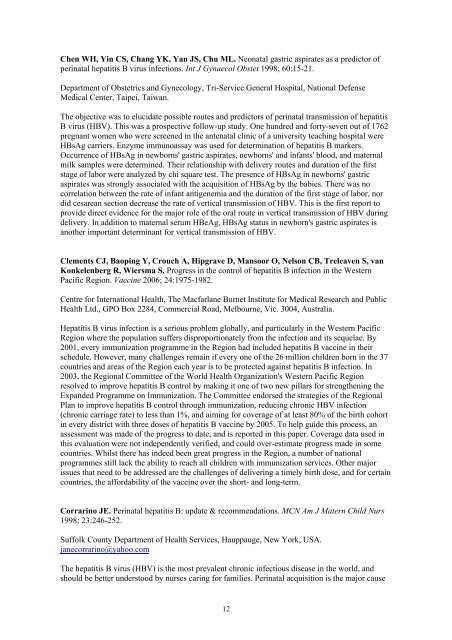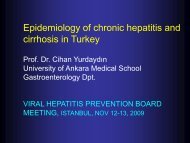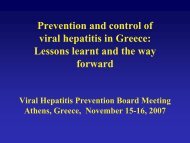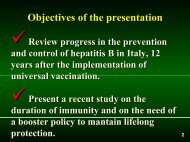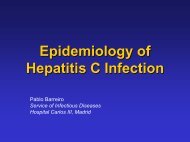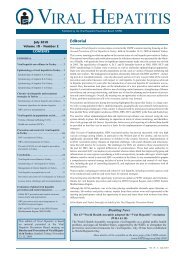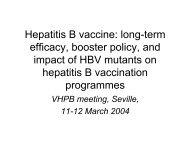Chen WH, Y<strong>in</strong> CS, Chang YK, Yan JS, Chu ML. Neonatal gastric aspirates as a predictor <strong>of</strong><strong>per<strong>in</strong>atal</strong> <strong>hepatitis</strong> B <strong>virus</strong> <strong>in</strong>fections. Int J Gynaecol Obstet 1998; 60:15-21.Department <strong>of</strong> Obstetrics <strong>and</strong> Gynecology, Tri-Service General Hospital, National DefenseMedical Center, Taipei, Taiwan.The objective was to elucidate possible routes <strong>and</strong> predictors <strong>of</strong> <strong>per<strong>in</strong>atal</strong> <strong>transmission</strong> <strong>of</strong> <strong>hepatitis</strong>B <strong>virus</strong> (HBV). This was a prospective follow-up study. One hundred <strong>and</strong> forty-seven out <strong>of</strong> 1762pregnant women who were screened <strong>in</strong> the antenatal cl<strong>in</strong>ic <strong>of</strong> a university teach<strong>in</strong>g hospital wereHBsAg carriers. Enzyme immunoassay was used for determ<strong>in</strong>ation <strong>of</strong> <strong>hepatitis</strong> B markers.Occurrence <strong>of</strong> HBsAg <strong>in</strong> newborns' gastric aspirates, newborns' <strong>and</strong> <strong>in</strong>fants' blood, <strong>and</strong> maternalmilk samples were determ<strong>in</strong>ed. Their relationship with delivery routes <strong>and</strong> duration <strong>of</strong> the firststage <strong>of</strong> labor were analyzed by chi square test. The presence <strong>of</strong> HBsAg <strong>in</strong> newborns' gastricaspirates was strongly associated with the acquisition <strong>of</strong> HBsAg by the babies. There was nocorrelation between the rate <strong>of</strong> <strong>in</strong>fant antigenemia <strong>and</strong> the duration <strong>of</strong> the first stage <strong>of</strong> labor, nordid cesarean section decrease the rate <strong>of</strong> vertical <strong>transmission</strong> <strong>of</strong> HBV. This is the first report toprovide direct evidence for the major role <strong>of</strong> the oral route <strong>in</strong> vertical <strong>transmission</strong> <strong>of</strong> HBV dur<strong>in</strong>gdelivery. In addition to maternal serum HBeAg, HBsAg status <strong>in</strong> newborn's gastric aspirates isanother important determ<strong>in</strong>ant for vertical <strong>transmission</strong> <strong>of</strong> HBV.Clements CJ, Baop<strong>in</strong>g Y, Crouch A, Hipgrave D, Mansoor O, Nelson CB, Treleaven S, vanKonkelenberg R, Wiersma S. Progress <strong>in</strong> the <strong>control</strong> <strong>of</strong> <strong>hepatitis</strong> B <strong>in</strong>fection <strong>in</strong> the WesternPacific Region. Vacc<strong>in</strong>e 2006; 24:1975-1982.Centre for International Health, The Macfarlane Burnet Institute for Medical Research <strong>and</strong> PublicHealth Ltd., GPO Box 2284, Commercial Road, Melbourne, Vic. 3004, Australia.Hepatitis B <strong>virus</strong> <strong>in</strong>fection is a serious problem globally, <strong>and</strong> particularly <strong>in</strong> the Western PacificRegion where the population suffers disproportionately from the <strong>in</strong>fection <strong>and</strong> its sequelae. By2001, every immunization programme <strong>in</strong> the Region had <strong>in</strong>cluded <strong>hepatitis</strong> B vacc<strong>in</strong>e <strong>in</strong> theirschedule. However, many challenges rema<strong>in</strong> if every one <strong>of</strong> the 26 million children born <strong>in</strong> the 37countries <strong>and</strong> areas <strong>of</strong> the Region each year is to be protected aga<strong>in</strong>st <strong>hepatitis</strong> B <strong>in</strong>fection. In2003, the Regional Committee <strong>of</strong> the World Health Organization's Western Pacific Regionresolved to improve <strong>hepatitis</strong> B <strong>control</strong> by mak<strong>in</strong>g it one <strong>of</strong> two new pillars for strengthen<strong>in</strong>g theExp<strong>and</strong>ed Programme on Immunization. The Committee endorsed the strategies <strong>of</strong> the RegionalPlan to improve <strong>hepatitis</strong> B <strong>control</strong> through immunization, reduc<strong>in</strong>g chronic HBV <strong>in</strong>fection(chronic carriage rate) to less than 1%, <strong>and</strong> aim<strong>in</strong>g for coverage <strong>of</strong> at least 80% <strong>of</strong> the birth cohort<strong>in</strong> every district with three doses <strong>of</strong> <strong>hepatitis</strong> B vacc<strong>in</strong>e by 2005. To help guide this process, anassessment was made <strong>of</strong> the progress to date, <strong>and</strong> is reported <strong>in</strong> this paper. Coverage data used <strong>in</strong>this evaluation were not <strong>in</strong>dependently verified, <strong>and</strong> could over-estimate progress made <strong>in</strong> somecountries. Whilst there has <strong>in</strong>deed been great progress <strong>in</strong> the Region, a number <strong>of</strong> nationalprogrammes still lack the ability to reach all children with immunization services. Other majorissues that need to be addressed are the challenges <strong>of</strong> deliver<strong>in</strong>g a timely birth dose, <strong>and</strong> for certa<strong>in</strong>countries, the affordability <strong>of</strong> the vacc<strong>in</strong>e over the short- <strong>and</strong> long-term.Corrar<strong>in</strong>o JE. Per<strong>in</strong>atal <strong>hepatitis</strong> B: update & recommendations. MCN Am J Matern Child Nurs1998; 23:246-252.Suffolk County Department <strong>of</strong> Health Services, Hauppauge, New York, USA.janecorrar<strong>in</strong>o@yahoo.comThe <strong>hepatitis</strong> B <strong>virus</strong> (HBV) is the most prevalent chronic <strong>in</strong>fectious disease <strong>in</strong> the world, <strong>and</strong>should be better understood by nurses car<strong>in</strong>g for families. Per<strong>in</strong>atal acquisition is the major cause12
<strong>of</strong> <strong>in</strong>fection <strong>in</strong> <strong>in</strong>fants <strong>and</strong> children. Without vacc<strong>in</strong>e dur<strong>in</strong>g <strong>in</strong>fancy, 90% <strong>of</strong> <strong>in</strong>fants born towomen positive for the <strong>virus</strong> will go on to become lifelong carriers. There are significant sequelaeassociated with HBV <strong>in</strong>fection, rang<strong>in</strong>g from fulm<strong>in</strong>ant HBV to chronic liver disease to an<strong>in</strong>creased risk for carc<strong>in</strong>oma. A comprehensive prevention <strong>and</strong> treatment strategy has beendeveloped by the Centers for Disease Control <strong>and</strong> <strong>Prevention</strong>, which <strong>in</strong>cludes screen<strong>in</strong>g <strong>of</strong> allpregnant women for the presence <strong>of</strong> HBV, the adm<strong>in</strong>istration <strong>of</strong> <strong>hepatitis</strong> B immunoglobul<strong>in</strong>(HBIg) at birth, <strong>and</strong> the adm<strong>in</strong>istration <strong>of</strong> <strong>hepatitis</strong> B vacc<strong>in</strong>e at birth, at 1 month <strong>of</strong> age, <strong>and</strong> at 6months <strong>of</strong> age. Nurses work<strong>in</strong>g <strong>in</strong> the <strong>per<strong>in</strong>atal</strong> <strong>and</strong> pediatric specialties must underst<strong>and</strong> theimplications <strong>of</strong> HBV to help prevent <strong>transmission</strong> <strong>and</strong> to assist <strong>in</strong> the coord<strong>in</strong>ation <strong>of</strong> care <strong>and</strong>advocacy for affected populations. The community health implications for the care <strong>of</strong> women <strong>and</strong>children with HBV are clear, giv<strong>in</strong>g nurses the opportunity to develop a closer l<strong>in</strong>kage betweenhospital- <strong>and</strong> community-based nurs<strong>in</strong>g practice.Da Villa G. Rationale for the <strong>in</strong>fant <strong>and</strong> adolescent vacc<strong>in</strong>ation programmes <strong>in</strong> Italy. Vacc<strong>in</strong>e2000; 18(Suppl 1):S31-S34.Italian Institute for the <strong>Prevention</strong> <strong>of</strong> Liver Diseases, Institute "Fern<strong>and</strong>o de Ritis", Via GeneraleOrs<strong>in</strong>i, 42-80132, Naples, Italy.In Italy <strong>in</strong> the 1980s, the <strong>in</strong>cidence <strong>of</strong> acute <strong>hepatitis</strong> B was about 13 per 100,000, correspond<strong>in</strong>gon average to 7500 new symptomatic cases per year was about 3%, mak<strong>in</strong>g Italy an area <strong>of</strong><strong>in</strong>termediate endemicity. HBV <strong>in</strong>fection was also associated with 12 per 100,000 deaths fromcirrhosis <strong>and</strong> with 5.1 per 100,000 deaths from hepatocellular carc<strong>in</strong>oma. In view <strong>of</strong> the largenumbers <strong>of</strong> pregnant women who were <strong>hepatitis</strong> B surface antigen (HBsAg)-positive, selective<strong>hepatitis</strong> B vacc<strong>in</strong>ation <strong>of</strong> all newborns to these mothers <strong>and</strong> <strong>of</strong> other high-risk groups was<strong>in</strong>troduced <strong>in</strong> 1983. Compliance was high among the newborns but low <strong>in</strong> other high-risk groups.Hepatitis vacc<strong>in</strong>ation was adopted <strong>in</strong> Italy <strong>in</strong> 1991, <strong>in</strong>clud<strong>in</strong>g each year all newborns, alladolescents aged 12 years <strong>and</strong> other high-risk groups. Compliance has been nearly 95% fornewborns <strong>and</strong> 80% for adolescents. S<strong>in</strong>ce the <strong>in</strong>troduction <strong>of</strong> vacc<strong>in</strong>ation, both the <strong>in</strong>cidence <strong>of</strong>acute <strong>hepatitis</strong> B <strong>and</strong> the prevalence <strong>of</strong> HBV carriage have fallen, the latter from 3.4% <strong>in</strong> 1985 to0.9% <strong>in</strong> 1996. There is good evidence that these decreases are ma<strong>in</strong>ly the result <strong>of</strong> the vacc<strong>in</strong>ationprogrammes. Although the full economic impact cannot yet be assessed, about 18,000 cases <strong>of</strong>acute HBV <strong>in</strong>fection have been prevented over the 6 years s<strong>in</strong>ce start<strong>in</strong>g the mass vacc<strong>in</strong>ationprogramme, with cost sav<strong>in</strong>gs <strong>of</strong> about US$ 244,308,000.Del Canho R, Grosheide PM, Schalm SW, de Vries RR, Heijt<strong>in</strong>k RA. Failure <strong>of</strong> neonatal<strong>hepatitis</strong> B vacc<strong>in</strong>ation: the role <strong>of</strong> HBV-DNA levels <strong>in</strong> <strong>hepatitis</strong> B carrier mothers <strong>and</strong> HLAantigens <strong>in</strong> neonates. J Hepatol 1994; 20:483-486.Department <strong>of</strong> Internal Medic<strong>in</strong>e II, University Hospital Dijkzigt, Rotterdam, The Netherl<strong>and</strong>s.In a <strong>hepatitis</strong> B vacc<strong>in</strong>ation program (1982-1992), 705 <strong>in</strong>fants born to HBsAg-positive mothersreceived HBIg with<strong>in</strong> 2 h <strong>of</strong> birth <strong>and</strong> were vacc<strong>in</strong>ated accord<strong>in</strong>g to a three- or four-dosevacc<strong>in</strong>ation schedule, start<strong>in</strong>g either at 3 months or directly after birth. Eight children HBsAgpositivedur<strong>in</strong>g the first year <strong>of</strong> life (group 1: <strong>in</strong>fected nonresponders). To determ<strong>in</strong>e whetherfailure <strong>of</strong> the <strong>hepatitis</strong> B vacc<strong>in</strong>ation was due to <strong>per<strong>in</strong>atal</strong> high-level maternal viraemia orgenetically determ<strong>in</strong>ed <strong>in</strong>fant nonresponsiveness to the vacc<strong>in</strong>e, we measured HBsAg <strong>and</strong> anti-HBs levels <strong>in</strong> <strong>in</strong>fants <strong>and</strong> HBeAg <strong>and</strong> <strong>hepatitis</strong> B <strong>virus</strong>-DNA levels <strong>in</strong> maternal serum, <strong>and</strong>determ<strong>in</strong>ed the HLA type <strong>of</strong> the <strong>in</strong>fants. Controls <strong>in</strong>cluded 14 <strong>in</strong>fants with a normal anti-HBsresponse 1 year after vacc<strong>in</strong>ation (group 2: non<strong>in</strong>fected responders) <strong>and</strong> all eight <strong>in</strong>fants withoutHBsAg <strong>and</strong> anti-HBs 1 year after vacc<strong>in</strong>ation (group 3: non<strong>in</strong>fected low responders). HBsAg,HBeAg <strong>and</strong> anti-HBs were measured by radioimmunoassay (Abbott Laboratories), <strong>hepatitis</strong> B<strong>virus</strong>-DNA was measured quantitatively by solution hybridization for groups 1, 2, <strong>and</strong> 3 (Abbott13
- Page 1 and 2: Pre-meeting documentPrevention and
- Page 3 and 4: Part I Prevention and control of pe
- Page 5 and 6: prevalence was significantly higher
- Page 7 and 8: clusters (obstetrics wards/hospital
- Page 9 and 10: Boxall E. Screening of pregnant wom
- Page 11: Chang MH, Hsu HY, Huang LM, Lee PI,
- Page 15 and 16: Eriksen EM, Perlman JA, Miller A, M
- Page 17 and 18: liver enzyme abnormalities than wer
- Page 19 and 20: health care, is feasible and achiev
- Page 21 and 22: HBsAg and anti-HBs in 4.5%. In the
- Page 23 and 24: immunoprophylaxis. Reflecting effec
- Page 25 and 26: Levin CE, Nelson CM, Widjaya A, Mon
- Page 27 and 28: Delaying vaccination of premature i
- Page 29 and 30: diagnosis. In the past, the inciden
- Page 31 and 32: shows that the prevalence of HBV in
- Page 33 and 34: Niu MT, Targonski PV, Stoll BJ, Alb
- Page 35 and 36: Ranger-Rogez S, Alain S, Denis F. H
- Page 37 and 38: vaccinees) and low reactogenicity o
- Page 39 and 40: single ELISA test is about Rs40. At
- Page 41 and 42: newborns with surface antigenemia,
- Page 43 and 44: Wang Z, Zhang J, Yang H, Li X, Wen
- Page 45 and 46: of hepatitis B vaccine. This study
- Page 47 and 48: transmission has been estimated at
- Page 49 and 50: at birth and 2 weeks after birth, f
- Page 51 and 52: Chubinishvili OV, Mikhailov MI, Sak
- Page 53 and 54: Jensen L, Heilmann C, Smith E, Want
- Page 55 and 56: Onishchenko GG. Incidence of infect
- Page 57: Zanetti A, Tanzi E, Semprini AE. He


